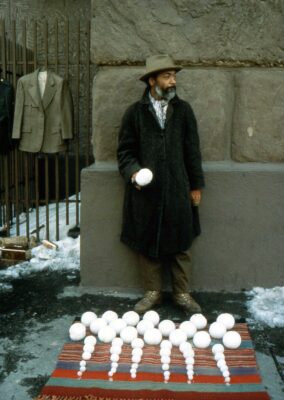The new documentary The Melt Goes on Forever: The Art & Times of David Hammons chronicles the singular career of the elusive African-American art star David Hammons from Watts rebellion era ’60s L.A. to global art world prominence today. Hammons’ category-defying practice – rooted in a deep critique of American society and the elite art world – is in the words of one art critic “an invitation to confront the fissures between races.” We open the film this Friday at the Monica Film Center.
The L.A. Times’ art critic Christopher Knight recently wrote about the film and Hammons, whom he describes as “among our greatest living artists.” Here’s an excerpt:
“In David Hammons’ most disarming art, seeming simplicity assumes sharp sophistication. It’s like a supercharged matryoshka doll, with each layer peeling back to reveal and fertilize another layer — and another, and another, and another, until a viewer is dizzy with exhaustion, both delightful and chastening.

“Black life in a white-dominated society has been Hammons’ focus for more than half a century, at least since the fateful year of 1968. That’s when he enrolled in what is now called Otis College of Art and Design to work with artist Charles White, back when the school was at the edge of L.A.’s MacArthur Park (the one that was then melting in the dark, all the sweet green icing flowing down). Today, at 79, Hammons is among our greatest living artists. His work is nothing less than a cultural touchstone for critical developments at the center of American art and life.
“A documentary film about a living artist is especially difficult to do when the subject won’t participate, including not sitting for an interview. That’s one reason why The Melt Goes on Forever: The Art & Times of David Hammons is noteworthy. The film is absorbing anyhow, minus the artist’s retrospective musings, thanks to contributions from many smart and observant artists and others.

“Hammons shows up now and then in rare documentary footage, which only adds to a distanced sense of disregard for norms that has been central to his aesthetic. That includes general indifference to the current clamor for celebrity driving so much contemporary culture.
“Surely the film’s well-established co-directors — Judd Tully, a longtime New York art writer, and Harold Crooks, an award-winning Canadian filmmaker — assumed before they started that they’d have to do without the artist’s direct contribution to their 2022 documentary. (It finally arrives Friday in Los Angeles at the Laemmle Monica Film Center, jumping to Amazon and Apple TV on July 5.) Hammons is famously elusive. I met him only once, in 1991, as he was finishing up a few minor details on the installation of a terrific midcareer survey at the Museum of Contemporary Art, San Diego. He was congenial, we exchanged pleasantries, and he was gone. The show, on the other hand, spoke with dazzling, sometimes strangely confounding eloquence…[the film] frames the larger narrative of a supremely gifted Black artist, moving through a white-dominated art world awash in ever-larger piles of cash, as a tale of humanity brutalized by stony economic transactions. In that, The Melt Goes on Forever: The Art & Times of David Hammons reverberates against the founding sins of U.S. history, which remain painfully operative today.”
